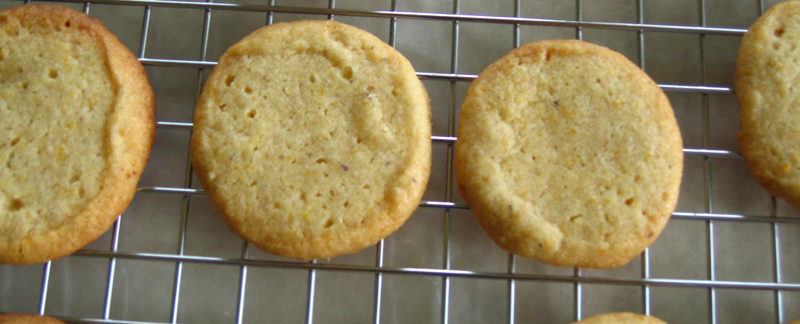I managed to bake my way thru 8 of the 10 recipes that I had planned for this weekend. Two cookies stood out as favorites: dark chocolate with chocolate chip and cherries, and lemon-lavender. Runners-up were: fig-walnut, and banana-date-coconut oat.
What always surprises me, no matter how often or how varied my creations, is that it is truly a matter of taste. Some like banana; some hate banana. Some like cherries; some hate cherries. Most like chocolate, but some love only citrus. It always fascinates me that taste is not universal. And because of that fact, I like to try different ideas and see who likes what and why.
As a result of sharing my weekend baking, I got a lot of requests for the lemon-lavender recipe. So here it is. If you try it, look for food-grade lavender buds. I found mine at an herbal tea shop that sells teas and spices. You don’t need much, so buy the smallest quantiy possible. Also note-worthy is that this recipe makes a lot of cookies. When I made it, I cut it in half (including the egg), so that I yielded about 2 1/2 dozen cookies. Cutting an egg yolk in half is pretty easy if you do it in one stroke, using a spoon. (I use a 1/2 tablespoon measuring spoon.) I hope you enjoy the reicpe. It is a very crispy cookie that is exceptionally lemony with a hint of lavender.
Lemon-Lavender Cookies
3/4 cup (5 1/4 oz.) granulated sugar
2 Tbsp. grated zest plus 2 Tbsp. juice from two lemons
2 teaspoons lavender buds
1 3/4 cups (8 1/4 oz.) all-purpose flour
1/4 tsp. salt
1/4 tsp. baking powder
12 Tbsp. ( 1 1/2 sticks) cold unsalted butter, cut into ½” cubes
1 lg. egg yolk
1/2 tsp. vanilla extract
In the bowl of food processor, process granulated sugar, lavender and zest until it looks damp and zest is thoroughly incorporated, about 30 seconds. Add flour, salt, and baking powder; pulse to combine, about 10 one-second pulses.
Scatter butter chunks over. Pulse until mixture resembles fine cornmeal, about 15 one-second pulses. In a measuring cup or small bowl, beat lemon juice, yolk, and vanilla until combined. With machine running, add juice/yolk mixture in slow, steady stream (process should take about 10 seconds); continue processing until dough begins to form ball, 10 to 15 seconds longer.
Turn dough and any dry bits out onto counter (or board); working quickly, gently knead the dough together to ensure no dry bits remain and dough is homogeneous. Roll dough into cylinder approximately 10 inches long and 2 inches in diameter. Center dough on piece of parchment (waxed paper or plastic wrap will work in a pinch ). Fold paper over dough. Grasp one end of parchment. With other hand, use bench scarper to firmly press parchment against dough to form uniform cylinder. Roll parchment and twist ends together to form tight seal. Chill dough until firm and cold, about 45 minutes in freezer or 2 hours in refrigerator.
Preheat oven to 375 degrees F. Line 2 baking sheets with parchment paper. Remove dough log from wrapping and, using a sharp chef’s knife, slice dough into rounds 3/8-inch thick. Place on prepared baking sheets, spacing them about 1 inch apart.
Bake until centers of cookies just begin to color and edges are golden brown, 14 to 16 minutes, rotating baking sheets front to back and top to bottom halfway through baking time.
Cool cookies on baking sheet about 5 minutes, using wide metal spatula, transfer cookies to wire rack and cool to room temperature.
